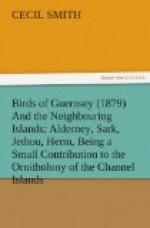Professor Ansted mentions the Laughing Gull in his list, by which I presume he means the present species, and marks it as only occurring in Guernsey. There is no specimen in the Museum. As it is just possible that the Mediterranean Black-headed Gull, Larus melanocephalus, may occur in the Islands,—as it does so in France as far as Bordeaux, and has once certainly extended its wanderings as far as the British Islands,—it may be worth while to point out the principal distinctions. In the adult bird the head of L. melanocephalus in the breeding-season is black, not brown as in L. ridibundus, and the first three primaries are white with the exception of a narrow streak of black on the outer web of the first, and not white with a black margin as in L. ridibundus. In younger birds, however, the primaries are a little more alike, but the first primary of L. melanocephalus is black or nearly so; in this state Mr. Howard Saunders has given plates of the first three primaries of L. melanocephalus and L. ridibundus, both being from birds of the year shot about March, in his paper on the Larinae, published in the ‘Proceedings of the Zoological Society’ for the year 1878.
172. LITTLE GULL. Larus minutus, Pallas. French, “Mouette pygmee.”—I have never met with this bird myself in the Channel Islands, nor have I seen a Channel Island specimen, but Mr. Harvie Brown, writing to the ‘Zoologist’ from St. Peter’s Port, Guernsey, under date January 25th, says, “In the bird-stuffer’s shop here I saw a Little Gull in the flesh, which had been shot a few days ago."[37] Mr. Harvie Brown does not give us any more information on the subject, and does not even say whether the bird was a young bird or an adult in winter plumage; but probably it was a young bird of the year in that sort of young Kittiwake or Tarrock plumage in which it occasionally occurs on the south coast of Devon.




